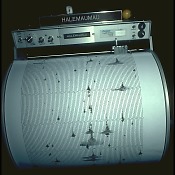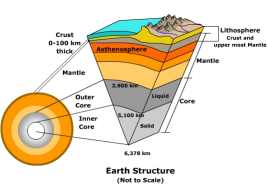The Earth's InteriorThe deep interior of the Earth remains somewhat of a mystery as we have only penetrated the very most outer portion with our deep drilling exploration. What knowledge we do have comes from seismic wave data or lava that has extruded onto the surface. What we do know is that the Earth's interior is somewhat like a concentric series of rings, progressing from the dense and intensely hot inner core toward the brittle outer shell of the crust. Geoscientist describe the layered interior of the earth on the basis of chemical composition or mechanical (physical) properties, like its ability to flow. Investigating the Earth's interior When seismic waves pass through
rock, their amplitude and direction changes. For instance, wave
velocity generally increases as rock density increases. Shear
waves do not penetrate molten masses and when they encounter a boundary
between two rock types of differing densities, a portion of the wave
travels along the boundary while another part returns to the surface.
Such changes in seismic wave velocities led Yugoslavian geophysicist
Andrija Mohorovicic (1857-1936) to discover the boundary between the
crust and underlying mantle. Wave velocity increases through the "Moho"
discontinuity. It is believed that the discontinuity represents a zone
where sima-type
minerals undergo a phase change that produces a new and denser
combination of minerals.
Figure 14.2 Video The Solid Earth Layers based on compositionThe outer brittle shell of the Earth
is the crust that
forms the "skin" of the lithosphere. The crust is primarily composed of silicate rocks and ranging in thickness of about 5 to 70 km (about 3 to 43.5 mi) The crust is broken into several
continental and oceanic tectonic (lithospheric)
plates. These plates ride atop the more pliable mantle
beneath, colliding to create great mountain systems and spreading apart
to form rift valleys. Figure 14.3 Interior
Structure of the Earth (Click
image to enlarge) The crust is divided into a basal
zone of oceanic crust called the sima
layer, and a less dense continental crust known as the sial
layer. The
sima is primarily composed of a
heavy, dark group of basaltic rocks. Primarily composed of silica and
magnesium, their high density (2800 to 3300 kg/m3)
is due to the large amounts of iron and magnesium. The sial,
named for the two predominate elements silicon and aluminum, is lighter
in weight with densities around 2700 - 2800 kg/m3.
Often geoscientists refer to rocks of the sial as "granitic rock" as
granite is a predominant rock type. The lower boundary of the sial
grades into the upper portion of sima. The sial actually has quite a
diversity of rock types, including large amounts of basaltic rocks. The
sima however is almost exclusively basaltic in composition. Separating the
upper mantle from the oceanic crust is the Moho Discontinuity. Seismic waves passing though this boundary increase their wave velocity
from 7 km (4 mi) per second to 8 km (5 mi) per second. The shift of
wave velocity is due to the change in rock composition and density. The mantle is over 2900 km thick (1801 mi)and comprises 80% of the Earth's total volume. It is mainly composed of a
dark, dense ultramafic rock called
peridotite Layers based on physical propertiesThe lithosphere is a rigid cool layer composed of the crust and the uppermost mantle. The asthenosphere is the least rigid portion of the mantle. It is a soft, easily deformed layer that is susceptible to slow convection caused by pockets of increased heat from the decay of radioactive elements. The mesosphere (not to be confused with the atmospheric layer of the same name) lies between the asthenosphere and core where the pressures are so great the mantle is solid. Finally, the core with its molten outer and rigid inner layers. Though intense heat is generated at such great depths, geoscientists believe that under the enormous overlying pressure the inner core is made of solid iron and nickel. The outer core is thought to be molten iron because shear-wave velocities drop to zero which occurs when they encounter a liquid. The interaction between the inner and outer core is thought to produce Earth's magnetic field.
Video: Difference between the crust and lithosphere
|
 Figure 14.1
Seismograph recording seismic activity. (Courtesy USGS Hawaii Volcano Observatory)
Figure 14.1
Seismograph recording seismic activity. (Courtesy USGS Hawaii Volcano Observatory)